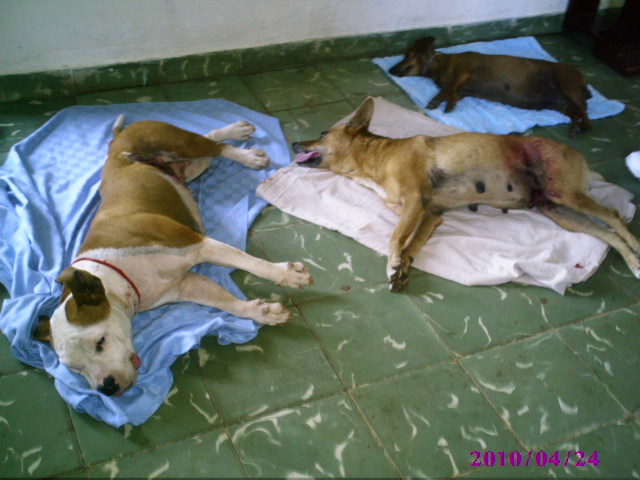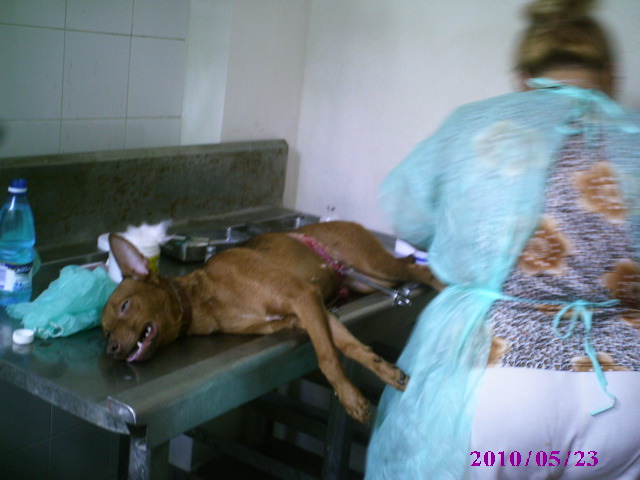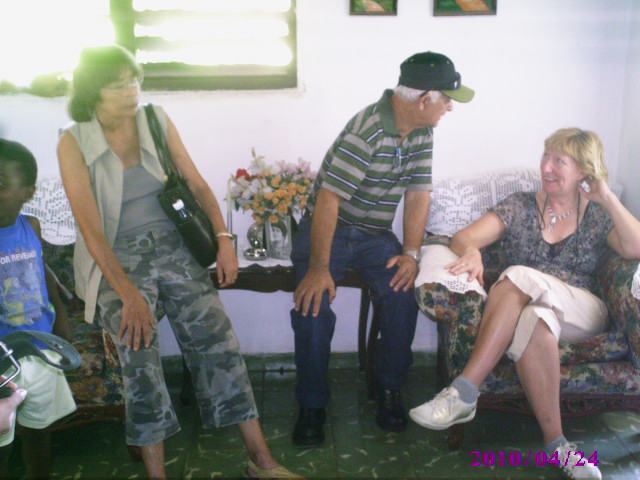A Drop in the Ocean
Yusimi Rodriguez

HAVANA TIMES, June 29 – I met Nora Garcia Gonzalez a few months back when I was with a group of friends at the office of the Association for the Protection of Animals and Plants (ANIPLANT), where she’s the director. On that occasion I didn’t have a chance to talk with her, but a couple months later I contacted her by phone concerning the exhibition “What’s Up with You?” by photographer and painter José Rolando Molina, to ask her a few questions. When I hung up I realized that I would need to set up a separate interview with Nora.
After more than a week trying to set a time, we decided to meet that Thursday afternoon at the ANIPLANT office. I arrived a bit early and waited. The eight dogs that live at the association barked a little at first but then calmed down. After a while though, they perked up again and began barking, wagging their tails and jumping; Nora was opening the door. She could only wave at us from a distance because she was in a hurry and barely had time to respond to my interview questions.
How did you first get interested in animals?
“It started when I was a year and a half old. I was a high-strung little girl; the only thing that would calm me down were hens and chicks, to such a point that my mom had to get me some that we kept out back. That was in the town of Caibarien, in central Cuba. From then on I raised all types of animals. My brother and I were both interested in the protection of animals, so when in 1986 Laura Alonso invited me to take part in the movement for the protection of animals, I was extremely appreciative.”
Tell me about the emergence of the association. What year was that, and how did it happen?
“It was created in 1987, because up until that moment there wasn’t a law that allowed the formation of any associations within civil society. There was already an organizing committee interested in founding the association. Therefore, when there appeared Law 54 allowing the creation of such associations, the necessary steps were taken so that our’s was approved by the Justice Ministry.”
And how did you end up being the president?
“In the first term of the association, very ambitious and almost unreachable goals were promised, including a law for the protection of animals and a shelter for them. People became discouraged because those things weren’t achieved.

My first position was as the secretary. I believe that it was my temperament, my fearlessness and also the force of my adoptive mother, Maria Alvarez Rios, that made me work so hard. I became president in 1992, a very difficult moment for the association. Nonetheless, we were able to get through that difficult stage of the 1990s, with its “Special Period” economic crisis,” and stay afloat. Today we have many projects.”
What does the work of the association consist of exactly?
“We’re involved in promoting education related to animals and a law for their protection. In fact a preliminary draft already exists. Vaccination campaigns are also being carried out and work is being done to control the number of animals in the streets through massive sterilization campaigns.”
You just mentioned the existence of a draft law to protect animals. What would that law consist of?
“It involves standardizing, in a law, all the violent acts committed against animals – mistreatment, cock fights, dog fights… There are even people here who sell little birds that are trained to fight to the death. There are also people who train hawks to kill doves, people who put traps on roofs and in trees.
“It is a shame because messenger pigeons sometimes do very useful and important work of carrying messages; such pigeons have been used even in times of war.”
But why do people do things like that?
“For simple enjoyment. The lowest instincts in people are reflected in the treatment of animals. I speak about these types of cruelty on the radio. We’re attempting to get these things treated as crimes that are punishable by law, because these days you can see people organizing dog fights, but since there’s no law against it, you can’t do anything. What is punishable by law is betting, but not the fact of making dogs fight.

There are many personalities in the arts, in sports and the sciences who have offered their support in making this law a reality; for example: Alicia Alonso, Eusebio Leal, Alfredo Guevara, Arturo Montoto, Devorah Andoyo and Reynaldo Gonzalez, to name just a few. There would have to be courts and lawyers trained to deal with this type of crime. We, the members of the association, don’t understand why a law like this doesn’t exist in our country when already in countries like Bolivia and Nicaragua there are laws protecting animals. Plus, these countries have signed off on the DUBA (the Universal Declaration of Animal Well-being). As for us, our association belongs to WSPA (the World Society for the Protection of Animals).”
You spoke to me just a minute ago about mass sterilization campaigns. That was something you were also promoting with the exhibition “What’s Up with You?” Nevertheless, the Zoonosis agency is also trying to control the number of dogs in the streets. They pick them up and then put them to sleep [using strychnine, causing great pain and suffering]. What do you think of those methods?
“I think they’re horrible and demean our country. I call this the “dark side of the moon,” the ugly part, the sad part. I recognize though that this is not the fault of Zoonosis, but of the dog’s owners who toss them out into the street. Zoonosis tries to fulfill a sanitation role, because you can imagine what it would be like if we didn’t control the number of animals there are in the street.
However, what I’m criticizing are the methods that are completely inhumane. Look, I’ll give you an example: people plan the number of children they’ll have according to their income, their housing, their needs… Dogs can’t do that; we have to help them.

When a female dog lives in the street and another dog mounts it, she’ll have puppies, and at some moment she’ll have to leave them to go look for food. But there are predators around; nature does its job because not all of the pups will survive that danger or disease. However, instead of controlling the birthrate of dogs, what we do is continue throwing them into the street after they’re born.”
Do you receive government funding to carry out your work? Where does the association get its resources?
“As a non-governmental organization, we don’t receive any government funding support. We are self-financed thanks to membership dues and donations we also receive. The state provides assistance in terms of administrative and legal support, and what’s possible through the Associations Department of the Ministry of Agriculture (MINAGRI).”
When we talked on the phone about the exhibit, you told me that this year it was in commemoration of Dog Day in Cuba and that for a long time this had had not taken place on that date in our country. How was the association able to reestablish this tradition?
“Well, it was thanks to Norma Rodriguez, from the Federation of Canine Sport, and also the Cynology Federation. The three institutions came together around research conducted by Zoila Portuondo into this tradition. A festival of dogs, called FESTICAN, was then held in the Pavilion Cuba on 23rd Street. This was in 1995, and starting from then, every year we’ve made a pilgrimage to the grave of Janet Ryder [the founder of Cuba’s first animal protection league] and have held other cultural activities.”
As for plants, what has your organization been able to do?
“Very little in fact. What we do is orient our members and the public on the use of plants as a source of food. This is done by Tito Núñez Gudás, an engineer who was the founder of the eco-restaurants at the Havana Botanical Garden and El Romero, in the Terrazas community in Pinar del Rio Province. But our work with animals takes up a lot of our time. We prioritize them because there are other associations in existence that are dedicated to plant life and the environment but not specifically to animals.”
So this association is unique in this country?
“Only one association of each type is allowed to exist.”
When we spoke last week about where to meet, you said that it had to be after you finished up at Radio Progreso. Does this mean you have a program on that station?
(At this moment, a couple of little dogs that managed to open the gate somehow came to “greet” her, as she continued responding to my question while petting them on their heads.)
“Thanks to Guillermo Vilar, the director of Juventud 2000, I have a program on Saturdays before the weekly concert. There I give advice and alerts, and talk about disease prevention. On alternating Tuesdays, I’m on “Frecuencia Total,” on the Radio Rebelde radio station, and I’m also often on the show “De Tarde en Casa,” moderated by Raquel Mayedo and Marino Luzardo.”
A few days ago when I was told you of a friend that found a dog and couldn’t take care of it, I thought you were going to say that we could bring it here, but you said that it would probably rot in the network. What does that consist of?
“Well, I already have the number of animals here that I can accommodate, and also, this is not a shelter. When you have more animals than you can handle then the problems get worse. The network is an adoption program for people who, for whatever reason, cannot continue caring for their pets, or for someone who has found one but cannot attend to it. Likewise, it’s for other people who want and are looking for a pet. We try to bring these two groups together. Sometimes we’re successful, but unfortunately we still get more requests from people who want to get rid of their animals. The most adversely affected are cats. Dogs have more opportunities for being wanted, but there are many prejudices toward cats.
“In Cuba, like in almost all the countries colonized by the Spanish, when somebody went about opening a corner bodega, the first thing they brought with them was a cat. The cat was treated with respect; it might not have a name, but it was “the cat.” This was how the owner guaranteed there weren’t any mice.
Also, dogs are excellent guards. A security guard can be sleeping, but the dog remains alert. Recently a dog was honored at the Institute of Geology and Paleontology because it prevented the robbery of two air conditioners. Sometime around 9:30 at night, the dog went to the entrance gate and began barking and indicating that something was in the area.
The security guards saw some men on the wall; they yelled at them and chased after them. Though there was an exchange of blows, the men escaped. There were four in all. The robbery of the air conditioners was prevented thanks to that black and white mutt because it was the first one that detected the thieves.
“Also, in the 90s, at the Napoleonic Museum, there was another nice experience. The director was Pantaleón, who created a team of guard dogs that stayed in a large and comfortable cage during the day. Starting at five in the afternoon they were let loose so they could “take care” of the museum. There were also some cats that kept the mice away.
“I’d also like to point out that there is an army of women and men —association members and non-members— who value animals and are concerned about their protection. One time, at the Dance Museum, a kitten fell into the roof drain and wandered into the sewer line. The workers could hear its meow, but they didn’t know where it was so that they could take it out. Alicia Alonso told them to break the pipe if necessary, that the cat had to be saved. So, that’s what they did. Firefighters and veterinarians came, everybody.
Fortunately, firefighters now help us when it’s necessary to rescue an animal that is stuck in some high place and can’t get down alone. There have also been cases in which people have left the country and have also left their pets locked up inside their houses. We’ve had to request permission to enter the home to rescue the animal, even sliding food under the door until we could get it open.”
Is there still much work to be done?
“Yes, but let me to tell you that recently I attended the Animal Care conference, which takes place every year in a city in the United States. This was the first time that I could attend, and on this occasion it took place in Nashville, Tennessee. There I saw that in rich countries, that have much greater resources, that few of these are dedicated to animals and that the situation is much worse than here. I felt very proud to be able to speak and show statistical charts about the progress made here, despite the blockade and all the problems we have. Right now I’m having talks with the organization Human Society International, from the United States, to carry out a collaborative project that will allow us to provide help to domestic animals.”
Is there anything that you would like to add Nora? …some message that you want to send to the readers of Havana Times?
“We’ll be able to improve the lives of animals a great deal when we all unite and form a chain of assistance. Mother Teresa of Calcutta said that sometimes we feel like what we’re doing is like a drop in the ocean, but that the ocean would be less if it lacked that drop. I would like to think that my drop in the ocean is this aid that I’m giving to animals. If somebody wants to request my advice or to help in some way, they can write me at: [email protected] ”
——
As we were leaving, I saw the guy who works with Nora at the association carefully closing the door behind us to make sure that one of the puppies didn’t get out. However I didn’t understand, since I thought that the dogs were already in their cages. But he explained, “It’s that now they’re loose inside the house; we’ve already feed them food and now they’re the owners.”
Walking away, I told Nora that I had heard someone talking about some medicine they had picked up earlier from a woman from the association for an operation on a dog at the veterinary clinic. “But you also give medicine for use in state clinics?” I asked her. “Sure, that’s another one of the things we do, and let’s hope we can continue to always do it,” Nora responded to me smiling. I walked with her a block and then watched her walk hurriedly down Infanta Avenue, like someone who still had a lot to do.






As this article demonstrates, getting the right things done is far more about organization and awareness, than it is about even having enough resources to accomplish the requisite tasks. In that sense socialism is far superior to the rich — but increasingly decadent and dead-end — West.
Of course, the resources are required too, to do the job right.